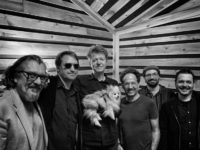There’s only one thing Nels Cline looks for in any of his collaborative projects: simpatico. He’s found it with Tim Berne, Jeff Tweedy, Wadada Leo Smith, Yoko Ono, and a host of other prominent artists from all styles and generations.
So when one legendary fellow guitarist told him about another guitarist who is a legend in the making, Cline had to find out what the fuss over this Julian Lage guy was all about. “I looked at a couple of things (on YouTube) and was stunned, amazed,” he confessed.
On November 25, 2014, Mack Avenue Records will release a summit meeting of these two guitarists that just from the juxtaposition of these names makes this no ordinary summit meeting: the bold, unpredictable Cline and the highly melodic and elegant former child prodigy Lage. Room (on sale November 25 from Mack Avenue Records) is the fruit of an unlikely encounter between a couple of plectrists from different generations with contrasting styles, who not only find plenty of common ground, but find it effortlessly.
We caught up with Cline between gigs while the two were touring North American together to find out why he’s stoked about working with Lage, why the duo works and how one of the towering giants of jazz guitar came to be responsible for making this happen…
S. VICTOR AARON: How did your pairing with Lage materialize?
NELS CLINE: We met through Jim Hall, the legendary jazz guitarist who sadly passed away this year. I met Jim because of his manager Brian Camelio, a guitarist in his own right and who founded the ArtistShare label that Jim was recording with for many years. Camelio became aware of an article I wrote in JazzTimes about ten tracks by Jim Hall and he mentioned this to Jim, who got in touch with me and started inviting me because of this (article) to these luncheons that Jim would have maybe once a month in my neighborhood that I live in, in the West Village, because Jim lived a block from me.
At these lunches – once I was finally able to go to them when I wasn’t on the road – I would hear about this Julian Lage person mostly from Jim and Scott Colley, the great bass player. They would tell stories about “Julian this” and “Julian that,” and finally, I thought I should YouTube this guy. I looked at a couple of things and was stunned, amazed. At that time I think he was 24 and I found he was from Santa Rosa, California and I’m from Los Angeles, so we’re both Californians.
Anyway, long story shorter, he showed up finally at one of these ‘crony’ lunches and he was such a delightful young man. We totally hit it off and then we started geeking out about guitars, we’d say “hey come by my house and check out this guitar,” and next thing you know, we started playing together. I was trying to do a drum-less ensemble idea around this time, and after some improvisation together that was pretty remarkably coherent from my standpoint, and I asked him about doing more music of that sort, and he said “absolutely.” And so it never really turned into a (full) ensemble, it just stayed as a duo. And we never looked back, we made a record called Room that will be out in November, and we’ll just try to play as many gigs as we can.
S. VICTOR AARON: Julian Lage has been in the spotlight ever since a documentary of him was done when he was eight years old. What have you discovered about Lage in working with him that people would still find surprising?
NELS CLINE: He’s constantly surprising because he’s so good. To me, there’s never anything predictable about being that good. There’s a lot of freedom and improvisation, chromatics and modernistic playing that he’s not associated with, and as such I feel he brings his so-called jazz work and bluegrass and folk-related work as well, but he’s very free in his own mind to change his technique to embrace certain sounds that might be rather unexpected if you just heard his work with Gary Burton, and that’s really surprising.
I’m not so much surprised now because we’ve become used to playing together but it is surprising to me because he has that freedom in his mind to embrace lots of texture, embracing chromaticism, embrace microtonality and extreme dynamics, so maybe people will find that surprising, too. I’m finding it less surprising all the time because we play a lot more, now. But it’s surprising to me that someone who could pretty much play it safe and be amazing in a more narrow aesthetic and is extremely vast in his ability to express himself on the instrument.
S. VICTOR AARON: I was going to ask you where do you two find common ground but I think you already answered that question.
NELS CLINE: There’s quite a bit, and it didn’t end up being anything that we ever really talked about. We talk about it now because we’ve built up a groundwork in our repertoire but when we started playing, it was a natural thing. We didn’t say “let’s play really free and chromatic and sound like a combination of the Jimmy Guiffre 3 and Lo Faber” — that’s not what we set out to do but it came about naturally. It totally made my dreams come true because it’s free but it sounds very organized, intimate and dynamic and it’s sort of ‘in’ and it’s sort of ‘out.’
S. VICTOR AARON: Will it just you two on the record?
NELS CLINE: That’s it, it’s live performances on the record, which means no production, per se.
S. VICTOR AARON: You and Julian have a stream out there for people to check out on your website. Will the new album with Julian planned for this fall sound a lot like that, and will this contain some more of those notorious Nels Cline left turns?
I don’t actually remember what’s on the website, but it’s melodic material that’s very tonal, and then there’s material that’s completely free and chromatic and pretty wild, but there are no effects pedals involved. Part of the record is an acoustic guitar duet and the other part is just two arch-top jazz guitars with no effects, just playing (through) the amplifiers. I do play a twelve string on a song or two but not on the record, so it’s just what we naturally gravitate toward. We both write, and we both do a lot of free improvisation.
S. VICTOR AARON: So, a combination of scored music and free improv…
NELS CLINE: Exactly, and sometimes it’s the improvisations themselves, directional improvisations moving from one thing to another in a rather episodic fashion.
- Christian Marien Quartett – ‘How Long Is Now’ (2024) - April 18, 2024
- Dave Douglas, feat. James Brandon Lewis – ‘Gifts’ (2024) - April 11, 2024
- Thollem – ‘Worlds In A Life, Two’ (2024) - April 8, 2024



